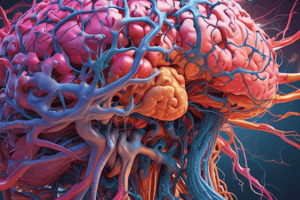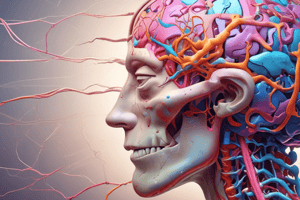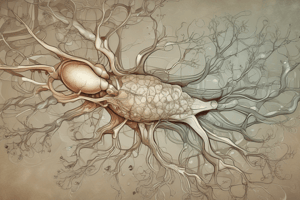Podcast
Questions and Answers
Which type of neuron is responsible for transmitting signals from the periphery to the central nervous system (CNS)?
Which type of neuron is responsible for transmitting signals from the periphery to the central nervous system (CNS)?
- Motor neurons
- Interneurons
- Afferent neurons (correct)
- Efferent neurons
Which type of glial cell is primarily involved in the myelination of central nervous system (CNS) neurons?
Which type of glial cell is primarily involved in the myelination of central nervous system (CNS) neurons?
- Oligodendrocyte (correct)
- Microglia
- Ependymal cell
- Astrocyte
What is the role of astrocytes in the nervous system?
What is the role of astrocytes in the nervous system?
- Myelination of axons in the PNS
- Scavenging pathogens in the CNS
- Maintenance of the chemical environment around neurons (correct)
- Phagocytosis of debris
Which of the following correctly describes how impulses are transmitted along a neuron?
Which of the following correctly describes how impulses are transmitted along a neuron?
Which classification of neurons is characterized by their role in relaying information within the central nervous system?
Which classification of neurons is characterized by their role in relaying information within the central nervous system?
What are the three main layers of the meninges that surround the brain and spinal cord?
What are the three main layers of the meninges that surround the brain and spinal cord?
What is the primary function of cerebrospinal fluid (CSF)?
What is the primary function of cerebrospinal fluid (CSF)?
How do waste products leave the brain tissue after being transported from capillary beds?
How do waste products leave the brain tissue after being transported from capillary beds?
Which type of barrier is formed by the endothelial cells of the brain's capillaries?
Which type of barrier is formed by the endothelial cells of the brain's capillaries?
What role do astrocytic end feet play in relation to the capillaries in the brain?
What role do astrocytic end feet play in relation to the capillaries in the brain?
Which type of neuron is characterized by having one axon and multiple dendrites?
Which type of neuron is characterized by having one axon and multiple dendrites?
What is the primary function of sensory neurons?
What is the primary function of sensory neurons?
Which division of the nervous system is responsible for motor innervation of cardiac muscle?
Which division of the nervous system is responsible for motor innervation of cardiac muscle?
What role do oligodendrocytes play in the central nervous system?
What role do oligodendrocytes play in the central nervous system?
Which type of glial cell is primarily associated with immune defense in the CNS?
Which type of glial cell is primarily associated with immune defense in the CNS?
The sympathetic division of the autonomic nervous system primarily prepares the body for which of the following responses?
The sympathetic division of the autonomic nervous system primarily prepares the body for which of the following responses?
What type of neuron primarily transmits signals from the sensory receptors to the CNS?
What type of neuron primarily transmits signals from the sensory receptors to the CNS?
What distinguishes an axon from dendrites in a neuron?
What distinguishes an axon from dendrites in a neuron?
Which of the following is NOT a structural type of neuron?
Which of the following is NOT a structural type of neuron?
Which glial cells are responsible for the formation of myelin in the peripheral nervous system?
Which glial cells are responsible for the formation of myelin in the peripheral nervous system?
Which division of the nervous system carries information to the CNS?
Which division of the nervous system carries information to the CNS?
What type of information do visceral sensory neurons process?
What type of information do visceral sensory neurons process?
How do interneurons contribute to the nervous system?
How do interneurons contribute to the nervous system?
Flashcards
Meninges
Meninges
Protective membranes surrounding the brain and spinal cord.
Blood-Brain Barrier (BBB)
Blood-Brain Barrier (BBB)
A selective barrier between blood and brain tissue. Prevents many substances from entering brain.
CNS Fluid Compartments
CNS Fluid Compartments
Different fluid environments in the central nervous system (brain and spinal cord)
Brain Vasculature
Brain Vasculature
Signup and view all the flashcards
Blood Brain Barrier function
Blood Brain Barrier function
Signup and view all the flashcards
Efferent neurons
Efferent neurons
Signup and view all the flashcards
Afferent neurons
Afferent neurons
Signup and view all the flashcards
Motor neurons
Motor neurons
Signup and view all the flashcards
Oligodendrocyte
Oligodendrocyte
Signup and view all the flashcards
Central Nervous System (CNS)
Central Nervous System (CNS)
Signup and view all the flashcards
Schwann cells
Schwann cells
Signup and view all the flashcards
Peripheral Nervous System (PNS)
Peripheral Nervous System (PNS)
Signup and view all the flashcards
Efferent division
Efferent division
Signup and view all the flashcards
Afferent division
Afferent division
Signup and view all the flashcards
Somatic Nervous System
Somatic Nervous System
Signup and view all the flashcards
Autonomic Nervous System
Autonomic Nervous System
Signup and view all the flashcards
Sympathetic division
Sympathetic division
Signup and view all the flashcards
Parasympathetic division
Parasympathetic division
Signup and view all the flashcards
Neuron
Neuron
Signup and view all the flashcards
Glial cells
Glial cells
Signup and view all the flashcards
Sensory neurons
Sensory neurons
Signup and view all the flashcards
Interneurons
Interneurons
Signup and view all the flashcards
Pseudo unipolar neuron
Pseudo unipolar neuron
Signup and view all the flashcards
Multipolar neuron
Multipolar neuron
Signup and view all the flashcards
Study Notes
Nervous System: Neuroanatomy
- The nervous system's main function is maintaining homeostasis, a stable internal environment.
- It achieves this by receiving, integrating, and analyzing information.
- This includes making decisions and sending instructions to control voluntary movement and influence endocrine function.
- The nervous system also regulates unconscious activities.
Nervous System Divisions
- The nervous system comprises the Central Nervous System (CNS) and the Peripheral Nervous System (PNS).
- The CNS includes the brain and spinal cord.
- The brain processes information, controls responses, sensations, movement, emotions, communication, thought, and memory.
- The spinal cord transmits information from the brain to the rest of the body and vice versa.
- The PNS includes nerve fibres located outside the brain and spinal cord.
- Nerve fibres carry information to and from the CNS.
Nervous System Divisions for Pain
- The CNS and PNS are fundamental to processing and understanding pain information.
- The afferent division carries information to the CNS, while the efferent division carries information from the CNS.
- The Somatic Sensory and Visceral Sensory branches are part of this afferent division, and provide information on touch, pressure, vibration, temperature, pain, sight, smell, taste, and equilibrium.
Cells of the Nervous System
- Neurons: Diverse structural types (pseudo-unipolar, bipolar, anaxonic, multipolar) with various functions (sensory, interneurons, motor). They form circuits to process information.
- Glial cells: Support neurons. In the CNS include oligodendrocytes, astrocytes, microglia, and ependymal cells. In the PNS include Schwann cells and satellite cells.
Nerve Cells and Nerve Communication
- Impulses are transferred between nerve cells electrically along the axon.
- Signals are transferred chemically at synapses.
Glial Cells in CNS and PNS
- CNS: Oligodendrocytes myelinate neurons, astrocytes connect neurons to capillaries, microglia remove debris and have immune functions, and ependymal cells create cerebrospinal fluid.
- PNS: Schwann cells myelinate neurons, and satellite cells surround neuron cell bodies.
Bundles of Axons
- Axons are bundled into nerves (PNS) or tracts (CNS).
- Axons and their Schwann cells are surrounded by a basal lamina in the PNS.
- Fascicles are bundles of axons surrounded by perineurium and form nerves surrounded by epineurium.
Ways to Divide the Nervous System/Neurons
- Categorization by direction (afferent or efferent). Afferent neurons carry information to the brain and spinal cord, while efferent neurons carry information from the brain and spinal cord.
- Categorization by type (sensory or motor). Motor neurons control muscles, while sensory neurons respond to stimuli.
- Categorization by function (autonomic or voluntary), and anatomy (CNS vs PNS). Somatic nervous system controls voluntary functions, while the autonomic nervous system controls involuntary functions.
CNS: Brain
- The brain develops from an embryonic tube and folds to create complex tissue structures.
- Structures include the cerebral cortex, cerebral nuclei (basal ganglia, amygdala, basal forebrain), thalamus, hypothalamus, retina, midbrain structures (superior and inferior colliculi, red nucleus, substantia nigra), pons, medulla oblongata, cerebellum.
CNS: Spinal Cord
- The spinal cord consists of gray and white matter.
- Transverse histological sections show different levels of cervical, thoracic, lumbar and sacral regions.
- Sections can be processed to simulate myelin staining.
PNS: Spinal Nerves and Cranial Nerves
- Spinal nerves carry signals to and from the spinal cord.
- Cranial nerves link the brain to sensory organs and muscles in the head and neck.
Spinal Cord and Spinal Nerves
- Sensory information enters the spinal cord through dorsal roots, and motor commands travel through ventral roots.
- Sensory and motor axons travel together in spinal nerves.
Meninges
- The brain and spinal cord are covered by the dura mater, arachnoid mater, and pia mater, in layers.
CNS Fluid Compartments
- Cerebrospinal fluid (CSF), interstitial fluid, and intracellular fluid are interlinked compartments. They support constant chemical environment and have barriers.
Brain Vasculature
- Blood vessels branch to supply the brain.
- Arteries branch into arterioles, providing capillaries for exchange.
- Venules collect waste and return blood to the heart.
Blood Brain Barrier
- A system regulating substances entering the brain.
- Tight junctions between endothelial cells prevent leakage.
Cerebrospinal Fluid
- Produced by the choroid plexus and circulates in the ventricals, central canal, and subarachnoid space.
- CSF protects and maintains a constant chemical environment.
Sensation and Sensory Processing
- Sensory receptors transduce external and internal environment energies into nerve signals.
- Sensory information travels through afferent nerves to the brain.
Sensory Systems
- Sensory systems include somatosensory, visual, auditory, vestibular (balance), olfactory (smell), and gustatory (taste)—specific to their organs and functions.
Studying That Suits You
Use AI to generate personalized quizzes and flashcards to suit your learning preferences.




